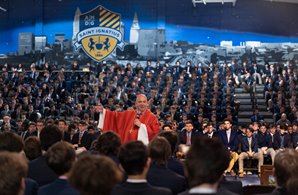 As of Tuesday, those of us who live in the Diocese of Cleveland are sheep without a shepherd. The retirement of Archbishop Charles Chaput is official, and Nelson Perez has been installed as his successor in the Archdiocese of Philadelphia. For those in the City of Brotherly Love this is a welcoming home of one of their adopted sons – Archbishop Perez having been born in Miami and raised in New Jersey, but ordained as a priest of the Archdiocese of Philadelphia in 1989 at the hands of then-Archbishop Anthony Bevilacqua.
As of Tuesday, those of us who live in the Diocese of Cleveland are sheep without a shepherd. The retirement of Archbishop Charles Chaput is official, and Nelson Perez has been installed as his successor in the Archdiocese of Philadelphia. For those in the City of Brotherly Love this is a welcoming home of one of their adopted sons – Archbishop Perez having been born in Miami and raised in New Jersey, but ordained as a priest of the Archdiocese of Philadelphia in 1989 at the hands of then-Archbishop Anthony Bevilacqua.
For those of us in the Diocese of Cleveland we await the decision of Rome on who will be the 11th successor to Bishop Louis Amadeus Rappe. In the 173-year history of the Diocese of Cleveland no bishop has had a briefer tenure than Bishop Perez, and so we are only three short years removed from the last appointment. As we await the announcement, it might be enlightening to look back at the previous appointments to see if we can divine who our next ordinary might be.
If history holds, then the probability of a local appointment would be quite low. Of the 11 bishops who have held the Cleveland post, only one, Bishop Emeritus Anthony Pilla, has been a native of the diocese. The next closest would have been Bishop Clarence Issenmann from Hamilton, just outside of Cincinnati.
Philadelphia is a more probable city of origin than Cleveland, since two of our previous bishops were priests of that archdiocese. Other than Bishop Perez, the list of Cleveland bishops includes Philadelphia native Ignatius Horstmann who, true to his name, founded the short-lived Loyola High School on Cleveland’s near east side in 1902.
Actually, if you go by previous appointments, there is a higher probability that the bishop will have been born in a foreign country than the state of Ohio. Three of the first five bishops were from Europe – Rappe from France, his successor Richard Gilmour was born in Dumbarton, Scotland, and our fifth bishop, Joseph Schrembs, was a native of the Bavarian town of Regensburg, also the home of Pope Emeritus Benedict XVI. But, these days the probability is much higher that he will come from the American Midwest, home of five of the last seven choices.
The probability is pretty high that our next bishop is already a member of the episcopate, since every bishop from Perez all the way back to Schrembs in 1921 was either a bishop or an auxiliary bishop prior to his appointment in Cleveland. Of that list of seven, two – Pilla and Issenmann – were already attached to Cleveland as auxiliary and coadjutor respectively. In the case of Issenmann, because he was coadjutor he was already given the right to succession and so became bishop upon the death of Archbishop Hoban in September of 1966.
Cleveland has never been an archdiocese, having always been under the jurisdiction of the Metropolitan Archdiocese of Cincinnati since its founding in 1847, but Edward Hoban was appointed and granted the personal title of Archbishop in 1951. This was the same title afforded to his predecessor Archbishop Schrembs in 1939.
If we look to lineage, there is a relative certainty that the successor to Bishop Perez will be able to trace his episcopal line back to John Carroll, the first American bishop and founding ordinary of the Archdiocese of Baltimore, as well as the namesake for our local Jesuit university. All but four of the previous eleven can trace their lineage through Carroll, and all three Europeans are linked with the famous Jesuit. Ironically, Bishop Pilla is a graduate of John Carroll University, yet his line does not pass through John Carroll. Instead it passes through Bishop Hickey, who ordained Pilla as Cleveland’s auxiliary in 1979 and through Cardinal Dearden of Detroit, himself a priest of the Diocese of Cleveland.
So, if history serves as an indicator of what to expect, we should check the lists of auxiliary bishops from around the country who hail from the Midwest and can trace their lineage to Archbishop John Carroll. But no matter who he is or what his background might be, let us pray that he is appointed and installed in less time than the nineteen months it took for Rome to give us Bishop Gilmour after the health-related resignation of Bishop Rappe. Yet, in retrospect we have to admit that it was worth the wait, for another more hasty choice might not have seen the wisdom in inviting Jesuits from Buffalo to the warmer climes of Cleveland in order to found that rather important academic institution known as St. Ignatius College.
A.M.D.G.
Did you enjoy this Lesson from Loyola Hall? If so, subscribe today, or share with a friend using the links below!